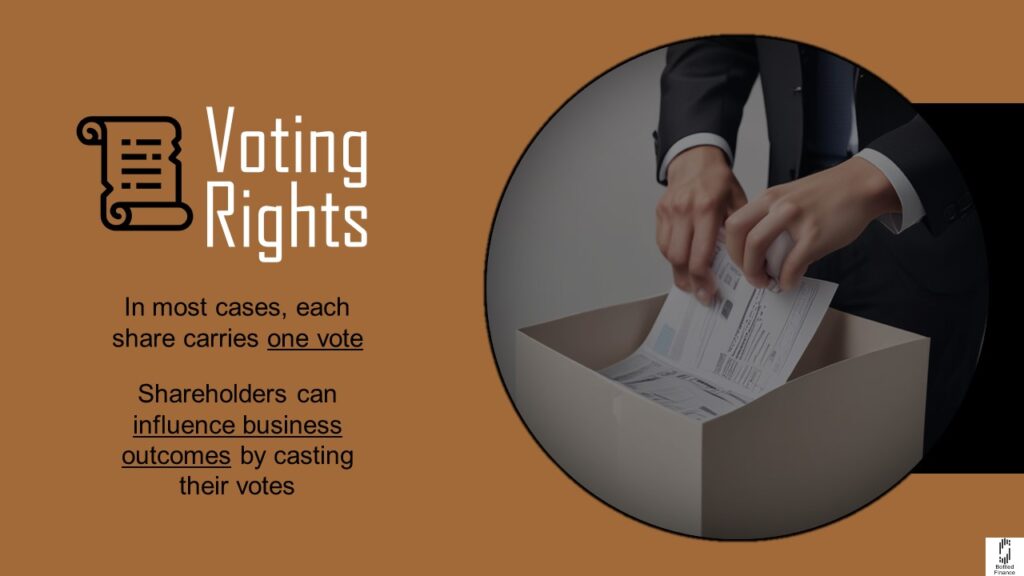Shareholders, who are owners of the company, are entitled to participate in certain business decisions.
These decisions, known as corporate action events, include any cash dividends and stock dividends that the company may be distributing (Chetty & Saez, 2005; Hobson, 2012; Kinsky, 2020; Cornell, 2020).
Additionally, ordinary shareholders are also eligible to voting rights, allowing them to influence business outcomes by casting their votes (Hobson, 2012; Kinsky, 2020).
Voting Rights

In most cases, each share carries one vote. If you have 100 shares of a company and another investor has 1,000 shares, their portion of ownership carries more voting rights than yours does (Hobson, 2012).
In a publicly traded company with hundreds, or even thousands, of shareholders, it is challenging to address issues and obtain consensus from every individual owner; therefore, a board of directors is appointed to oversee operations and protect shareholder interests (Kinsky, 2020).
Comprising of competent and qualified individuals within the industry, these board members regularly gather to understand the company’s performance, direction, and whether there are needs for changes and improvements (Kinsky, 2020).
Annual General Meeting (AGM) / Extraordinary General Meeting (EGM)

Unlike a board meeting, an annual general meeting (AGM) is typically held once a year and serves as a crucial forum for shareholders to vote on significant business matters. At this meeting, shareholders can influence decisions such as nominating or voting for a change in directors, and the director’s compensation (Kinsky, 2020).
Companies may also hold extraordinary general meetings (EGM) to discuss and obtain shareholders’ consensus to address urgent or exceptional matters requiring shareholder consensus, such as material changes in the operations and business of the firms (Kinsky, 2020).
Cash Dividend Distribution

Shareholders are entitled to a portion of the firm’s profits. One of the ways firms distribute their profits to their owners is through dividend distribution (Chetty & Saez, 2005).
There are two types of cash dividend distribution: regular and special; Regular dividends are periodic payouts whereas special dividends are rare additional payouts on top of the regular dividend distribution (Chetty & Saez, 2005).
Stock Dividend Distribution / Stock Split

Aside from cash, the company can also choose to distribute additional shares to their shareholders.
Known as a bonus issue and is similar to a stock split; the shareholders would receive additional shares in proportion to their current shareholdings (Hobson, 2012; Kinsky, 2020; Cornell, 2020).
However, unlike stock splits, with a stock dividend distribution, the new shares are issued using a portion of the firm’s retained earnings, so theoretically, there should be no change in the par value of the stock (Baker, Singleton, & Veit, 2011).
Share Consolidation / Reverse Stock Split

Firms may choose to consolidate their existing shares through a process known as a reverse stock split (Blau et al., 2023; Hobson, 2012)
In a reverse stock split, shares are combined to reduce the total number of shares outstanding. This consolidation typically results in a higher share price without fundamentally altering the stock’s par value (Blau et al., 2023).
In a 10-to-one share consolidation, every 10 shares held will be converted into one share, and at the end of the consolidation, the total number of shares outstanding will be only 10% of the quantity before consolidation (1/10; and if the ratio is 100-to-1 then 1/100 or 1%) (Hobson, 2012).
Merger & Acquisition (M&A), Takeovers, and Splits

Merger and acquisition (M&A) occur when two companies combine to form a single entity, typically through mutual agreement (Kinsky, 2020).
M&A transactions are generally nonhostile and involve both companies consenting to the merger (Kinsky, 2020).
A takeover, on the other hand, happens when one company acquires majority (if not all) of the other company’s stocks, making them the majority (or sole) shareholder of the (usually) smaller company (Kinsky, 2020).
Hostile takeovers result in the acquiring company becoming the majority or sole shareholder of the target company (Kinsky, 2020).
Firms may choose to split or spin-off divisions into separate entities (Kinsky, 2020).
This strategic move can occur when a division has distinct economic advantage or strategic priorities different from the rest of the company (Kinsky, 2020).
Concluding Remarks
Being a shareholder means holding a stake in a company, which includes benefits like profit sharing and the right to vote.
Recognizing their ownership role and the perks that follow should give investors a perspective of their position and what it means for a business to work for you.
Nevertheless, every investment carries risk, so investors should carefully evaluate their risk tolerance before making decisions.
References
Baker, H. K., Singleton, J. C., & Veit, E. T. (2011). Dividends and Dividend Policy. In Survey Research in Corporate Finance. Oxford University Press. https://doi.org/10.1093/acprof:oso/9780195340372.003.0006
Blau, B. M., Cox, J. S., Griffith, T. G., & Voges, R. (2023). Daily short selling around reverse stock splits. Journal of Financial Markets (Amsterdam, Netherlands), 65, 100832-. https://doi.org/10.1016/j.finmar.2023.100832
Chetty, R., & Saez, E. (2005). Dividend Taxes and Corporate Behavior: Evidence from the 2003 Dividend Tax Cut. The Quarterly Journal of Economics, 120(3), 791–833. https://doi.org/10.1093/qje/120.3.79
Cornell, B. (2020). The Tesla stock split experiment. Journal of Asset Management, 21(7), 647-651. https://doi.org/10.1057/s41260-020-00191-0
Hobson, R. (2012). Shares Made Simple : A Beginner’s Guide to the Stock Market. Harriman House Publishing.
Kinsky, R. (2020). Teach Yourself about Shares : A Self-Help Guide to Successful Share Investing. John Wiley & Sons, Incorporated.
Other Useful Readings
BarCharts, I. (2017). Corporate finance : Quickstudy reference guide. BarCharts Publishing, Inc..
Olvik, A., & Kangro, R. (2015). Pricing of Warrants with Stock Price Dependent Threshold Conditions. Mathematical Modelling and Analysis, 20(4), 516-528. https://doi.org/10.3846/13926292.2015.1073187
